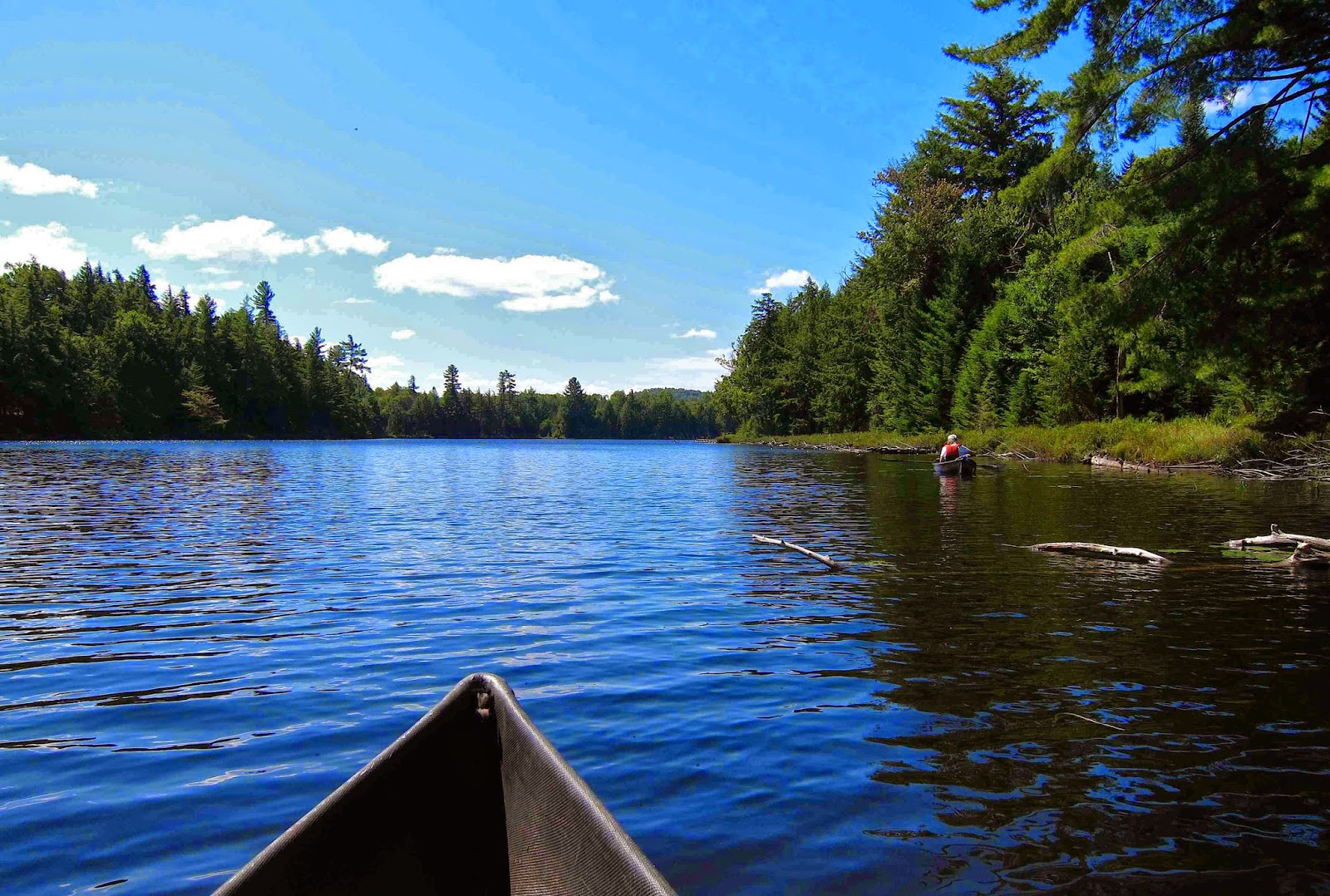This spectacular tract of over 7,000 acres of former Finch Pruyn timberlands containing 9 lakes and 3 ponds was only recently made accessible to the public, following purchase by the state from The Nature Conservancy late last year. Of course, Evelyn has visited this woods-and-waterways treasure before, when she saw that many of the lakes were lined with marble. Our objective today was to see how the presence of so much marble might have influenced the species of plant life that proliferated along the shores. And also have a great paddle on some beautiful lakes on an equally beautiful day.
After an easy quarter-mile walk from the parking area, we launched our boats onto Deer Pond and set out to explore the shore.
A friend had told us we would find some caves along the shore just after turning to paddle counter-clockwise around the pond, but it wasn't until we had reached the far shore that we began to see the steep marble banks that millennia of lapping waters had undercut.
Here we found the marble rocks eroded into graceful curves and deep, dark indentations.
Although we didn't find any significant preponderance of calciphile plants at Deer Pond, we did find a truly remarkable abundance of the bryozoan Pectinatella magnifica that had formed underwater on fallen branches. These gelatinous colonies of "moss animals" glowed eerily in the shallow depths where the sunlight could reach them.
I was able to lift one of the bryozoans above the water, where we could examine the coral-like creatures that covered the mass of dense jelly that had formed around the branch. Much as coral does, these creatures feed on organisms they filter from the water.
Our next destination was Third Lake, which lay a half-mile hike beyond where we pulled our canoes from Deer Pond. When we reached the put-in at Third Lake, I was charmed by the sight of these bright-red Bunchberry fruits.
I was also charmed by the spectacular view of mountain peaks beyond Third Lake's expanse of bright-blue water.
Here, too, the lake was rimmed by steep banks of marble bedrock. In many places, lime-loving White Cedars had taken root in cracks in the rock.
And again, we found many fascinating configurations where the soft rock had been eroded by lapping water.
This goldenrod was one of the most abundant blooming plants that had taken root in the marble crevices. After observing its spike-like habit of bloom and the dense hairiness of its leaves and stems, we are guessing that this is the species Hairy Goldenrod (Solidago hispida). Newcomb's Wildflower Guide tends to confirm our guess by describing its habitat as "rocky slopes, mostly in limestone regions." (Marble is composed of metamorphosed limestone.)
Purple-stemmed Aster (Symphyotrichum puniceum) was also abundant along the shore of Third Lake, but this is a species that happily grows in either acid or basic soils.
I don't know if this lichen needs lime to survive, but whatever species it is, it was thriving on the face of a marble bank. (The presence of the neighboring orange alga indicates a calcareous substrate, for sure, since Trentepohlia aurea must have lime to survive.) The lichen was rather spooky looking, like tiny skulls, dotted as it was with deep brown pits.
UPDATE: This is the lichen Solorina saccata, also called Chocolate Chip Lichen, known to grow only on calcareous rocks like those on the shores of Third Lake.
This was another interesting denizen of Third Lake. At first I thought it was a submerged pine bough, but a closer look revealed the stiff green fingers of freshwater sponge. Despite its green color, this is not a plant, but a colony of animals, similar to coral animals or those bryozoans, that filter-feed on tiny organisms in the water.
Here's a closer look at that sponge. Or should I say those sponges? Despite its slimy appearance in this photograph, it really had a gritty feel, from its structures composed of calcium or silica.
The whole day that Evelyn and I were on these waters, we encountered only three people: one fellow paddler we met at a launching site and two park rangers we spied at a distance crossing Third Lake in their canoe. I wonder if this Loon was used to having these waters all to himself. He certainly put up a howl when he saw us, his haunting cries sounding across the silent Adirondack lake to echo from distant mountains. A perfect Adirondack experience!


















8 comments:
What a wonderful trip and adventure, thanks so much for taking us along.
What a wonderful adventure! And a beautiful rocky. Shoreline.
This was such a relaxing post.
Very nice post. Having moved from NY to Ohio many years ago, I'd forgotten how beautiful the Adirondack back country is.
Oh how wonderful!
thnx 4 giving us this wonderful glimpse of our new paddling gem. looking forward to exploring the essex chain .,., hoping the carries will be wheelable for our aluminum canoe.
Wonderful, but I'd like to use a rowboat for a more stable fishing platform with my sons.
Peter, you forgot to mention that you were a member of the Gooley Club to scout the land for the Nature Conservancy and you helped them accommodate high net worth donors to funnel taxpayer money to finance Charitable Trusts!
Why did you disturb the natural elements like a typical tourist???
Post a Comment